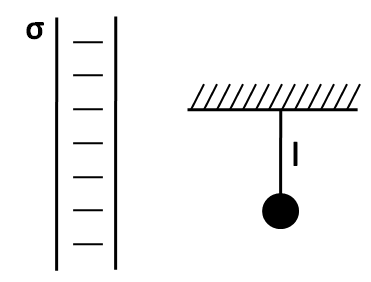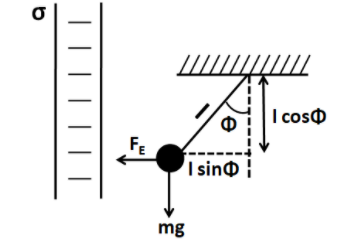Question
Question: A simple pendulum of length \(l\) and bob mass \(m\) is hanging in front of a large non-conducting s...
A simple pendulum of length l and bob mass m is hanging in front of a large non-conducting sheet having surface charge density σ. If suddenly a charge +q is given to the bob and it is released from the position shown in figure. The maximum angle through which the string is deflected is xtan−1(2ε0mgσq). Find x

Solution
To solve this question, we need to use the work energy theorem. For this we need to find out the total work done by the electrostatic and the gravitational forces on the bob. This work done has to be equated with the change in total kinetic energy of the bob.
Formula used: The formula used for solving this question is given by
E=2ε0σ, here E is the electric field due to an infinite charged sheet having a surface charge density of σ.
Complete step-by-step solution:
Let the maximum deflection angle of the string be φ.
Since the sheet is negatively charged and the bob is given a positive charge, so the bob will be attracted towards the sheet. We know that the electric field due to a single large charged sheet at a point is given by
E=2ε0σ
Since the bob has a charge of +q, so the electrostatic force on the bob is given by
FE=qE
⇒FE=2ε0qσ...............(1)
Consider the bob at its maximum deflection position.

The horizontal displacement of the bob is given by
x=lsinφ
Since the electrostatic force is towards the left, so the work done by the electrostatic force can be given by
WE=FE(lsinφ)
Putting (1) in the above equation, we have
WE=2ε0qσlsinφ................(2)
Also, the upward displacement of the bob is given by
y=l−lcosφ
⇒y=l(1−cosφ)
Since the weight of the bob acts vertically downwards, so the work done is negative and its given by
WG=−mgl(1−cosφ).............(3)
Adding (2) and (3) we get the net work done on the bob as
W=2ε0qσlsinφ−mgl(1−cosφ)............(4)
Now, according to the work energy theorem, this work done is equal to the change in kinetic energy of the bob from the initial to the final position. So we have
W=ΔK................(5)
Since the bob was at rest initially, so its initial kinetic energy is zero. Also, we know that the velocity of the bob at the extreme position is equal to zero. So the final kinetic energy is also equal to zero. This implies that the total change in the kinetic energy of the bob is equal to zero. Therefore from (5) we have
W=0
From (4)
2ε0qσlsinφ−mgl(1−cosφ)=0
⇒2ε0qσlsinφ=mgl(1−cosφ)
Cancelling l from both the sides, we have
2ε0qσsinφ=mg(1−cosφ)
Now, we know that 1−cosφ=2sin22φ and sinφ=2sin2φcos2φ. Substituting these in the above equation, we get
2ε0qσ2sin2φcos2φ=2mgsin22φ
⇒ε0qσsin2φcos2φ=2mgsin22φ
Dividing both sides by sin2φcos2φ, we get
ε0qσ=2mgtan2φ
⇒tan2φ=2mgε0qσ
Taking inverse tangent both the sides, we get
2φ=tan−1(2mgε0qσ)
⇒φ=2tan−1(2mgε0qσ)............(6)
According to the question, we have
⇒φ=xtan−1(2ε0mgσq).......................(7)
Comparing (6) and (7) we finally get
x=2
Hence, the value of x is equal to 2.
Note: Do not apply the equilibrium to find out the maximum deflection. This is because that will be the deflection, about which the pendulum will oscillate. At the maximum deflection position, the bob will not be in equilibrium but will have a net force towards the equilibrium position.
